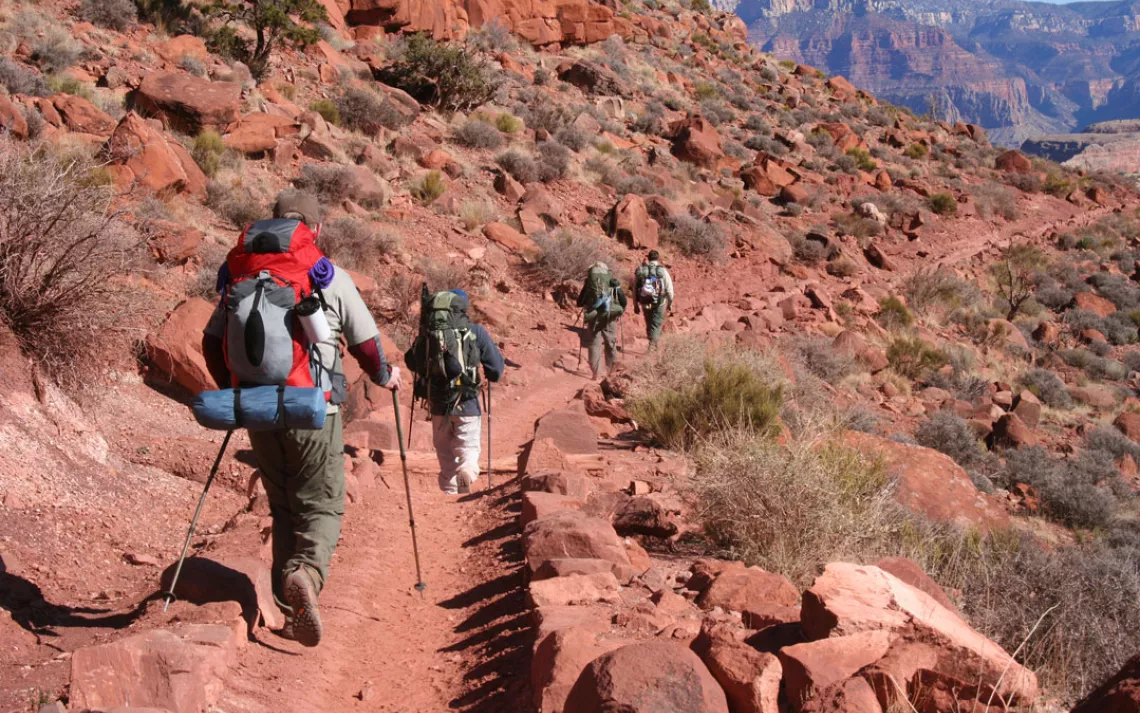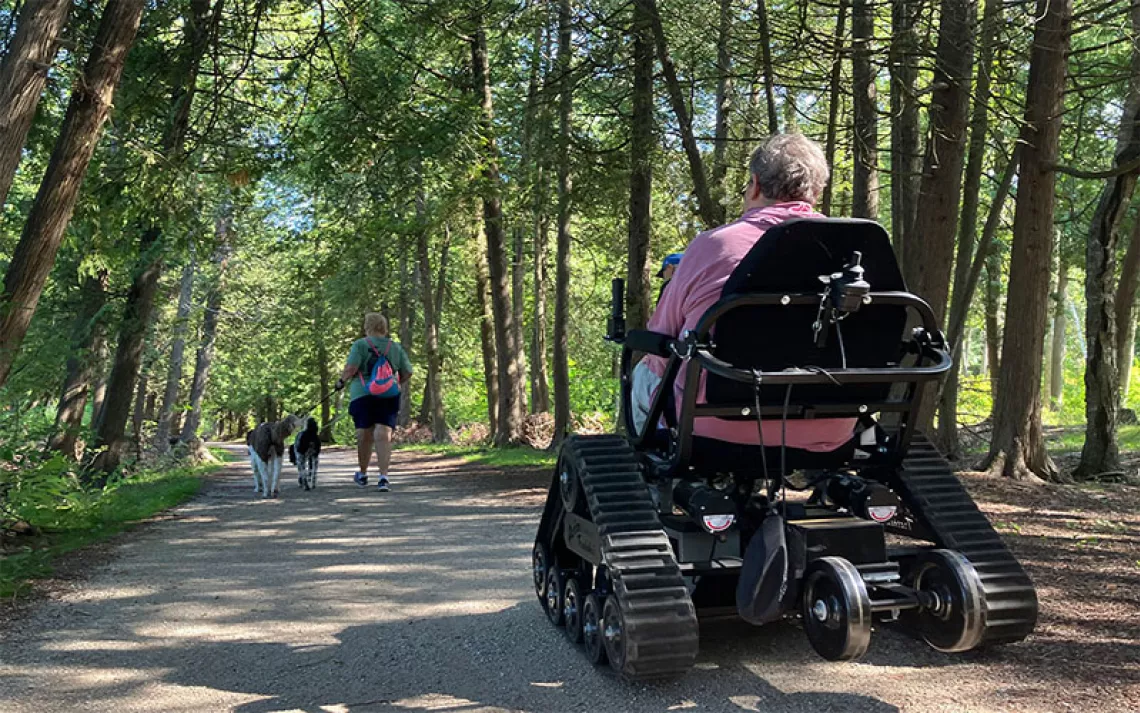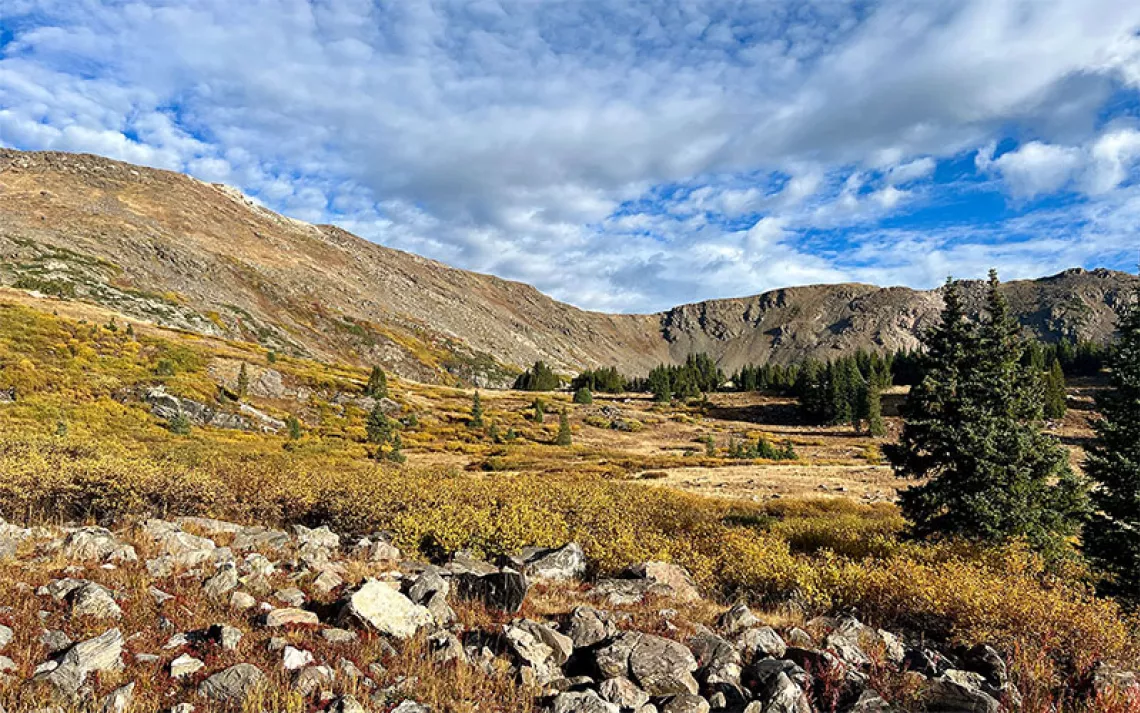A Grand Mistake at Grand Canyon National Park
A proposal to reduce the size of backcountry groups could end up keeping away the canyon’s most important defenders

Backpackers hike along a trail. | Photo by Paige Falk/iStock
More than a century ago, John Muir, founder of the Sierra Club, offered a blueprint of sorts for spurring people to become involved in protecting the environment. In his book Our National Parks, Muir wrote, “Thousands of tired, nerve-shaken, over-civilized people are beginning to find out that going to the mountains is going home; that wildness is a necessity; and that mountain parks and reservations are useful not only as fountains of timber and irrigating rivers, but as fountains of life.”
That sentiment has guided the Sierra Club’s Outings program from its inception in 1901, the same year those lines were written. The strategy has spread far beyond this one organization, and has become something of a bedrock ideal within the conservation community. To get people to protect wild places, first introduce them to those places, because they will not defend what they do not know.
Today, the outings-based strategy of creating new conservationists is at risk in at least one iconic wild place: Grand Canyon National Park. For years, Park Service officials there have been whittling down the number of routes that are permitted for larger groups of backpackers; by my count, dozens of routes that could once accommodate trips of one to two weeks are no longer open to outfitters. The current maximum group size on commercially outfitted trips is 11 people; it used to be 16. Now, the Park Service is considering a proposal in its pending backcountry management plan that would reduce the size of groups to six people. Such changes could well mean the end of Sierra Club Outings in the park. (Although Sierra Club Outings barely breaks even, the National Park Service considers the organization a commercial outfitter because the Club has some paid staff to administer its program.)
If the Park Service’s proposed change were to become the new regulation, it would dramatically reduce the number of people who get to experience the canyon’s wilderness—and in doing so, set back the effort to create more life-long conservationists.
The Park Service says it is reconsidering the size of groups in the backcountry in order to protect the park’s sensitive desert ecosystems from damage or overuse. It’s a reasonable concern; after all, no one wants a Grand Canyon that has been loved to death. But while the agency’s avowed goal may be sound, its chosen method isn’t. The Park Service has not cited any science supporting the notion that two six-person trips have less impact than, say, one 11-person trip. The reason for that omission is simple: There is no such science.
The National Park Service is poised to sacrifice one critical resource (passionate human advocacy to preserve the canyon) in an effort to protect another resource (the park’s natural beauty and ecological health). It doesn’t have to be this way. The agency’s landscape preservation goals can be met without such an extreme cut in the group size of backcountry trips. The situation simply calls for creativity—a scalpel rather than a hatchet.
The Sierra Club has spelled out those alternative steps in its formal comments on the backcountry proposal, which you can find here. The Club agrees that the main rim-to-rim corridor—which includes the Bright Angel Trail, Phantom Ranch, Indian Gardens, Cottonwood, and the North and South Kaibab—has huge problems with overcrowding. But we are concerned that the proposed management changes in other backcountry areas would create a virtual monopoly for one or two outfitters.
Barbara West, a retired park ranger who also served as superintendent at Voyageurs National Park and Chaco Culture National Historical Park, notes that not every group of a dozen or so is like every other group of a similar size. “A bane of my existence as a park manager was large, unsupervised groups, a lot of them church or scouting groups, whose leaders just turned them loose in the park,” she told me. “I saw everything from kids stoning turtles to death to adults cutting every branch within reach to toast marshmallows. I never saw anything of the sort from Sierra Club groups. Most were volunteers there to help us do what we lacked the money to do otherwise.”
This is an essential point. In recent years, Congress has beggared the National Park Service, along with other public land management agencies. Park managers struggle to find resources to stay on top of maintenance projects, and the Park Service’s total maintenance backlog has now climbed to nearly $12 billion worth of deferred projects.
Carefully organized trips, like those hosted by the Sierra Club, don’t have to be a drain on Grand Canyon National Park’s budgetary resources. Instead, they can help conserve and grow the park’s financial resources by assisting with park maintenance, reducing search and rescue costs, and lobbying for larger budgets for the Park Service.
Each year, Sierra Club Outings hosts dozens of service and volunteer trips during which participants build trails, help with ecosystem restoration projects, or repair historic sites. While we don’t currently have any service trips scheduled for the Grand Canyon, we’re standing by to help with the unglamorous work of restoring trails and (literally) mending fences.
There are also some important practical reasons for retaining group size at something close to its current level. As a trip leader, I need the support of a co-leader. Wilderness is a challenging place. Injuries are an ever-present danger. Suppose we have only a single leader and someone needs to walk an injured hiker out for treatment? If there is only one leader, that “someone” is the leader herself. That means either leaving the remainder of an inexperienced group alone in the wilderness or taking everyone out, thus ruining everyone’s trip. Or else calling in an expensive (and perhaps otherwise unnecessary) helicopter evacuation.
Then there are the harder to quantify, but very valuable, returns on investment the parks receive from people who go on well-organized trips. Already, past participants of Sierra Club Outings are vocal proponents of the Park Service and its mission. Those who have experienced the parks are the likeliest to engage in working to protect places such as the Grand Canyon, whether it is through lobbying Congress for more funds or spreading the word among friends and neighbors. Over the years, no organization has fought more vigorously to protect Grand Canyon National Park than the Sierra Club, whether the fight turned on dams, uranium mining on the park’s periphery, or helicopter flights of the canyon’s interior. It is hard to think of a less opportune time for the National Park Service to risk a steady supply of eager advocates.
There is always a danger in arguing public policy from a personal perspective, but I believe my own experience as a veteran Sierra Club National Outings leader, mainly in the Grand Canyon, exemplifies the experience of thousands of other Americans, and can shed further light on the agency’s ill-conceived backcountry proposal.
I was born, grew up, and went to college in New York. I knew nothing of wild places, nothing of the national park system, and little about the Grand Canyon until 1971, when I went on a trip down the Colorado River. Two years later, I went on my first backpacking adventure into North Bass, a remote canyon on the north side of the park.
Those two trips transformed my life. They taught me about wild places, about their value, about conservation advocacy. They taught me wilderness skills and respect for the environment. They showed me a night sky afire with stars, a night sky I barely knew existed and had never before seen. They also taught me a good bit about myself. Few things teach humility more effectively than an experience of rank incompetence.
From that point on, my conservation advocacy continued to deepen. In the early 1980s, I began leading Sierra Club National Outings. I joined the board of the Sierra Club Foundation, and got involved with many other groups working for wildlands protections, such as the Southern Utah Wilderness Alliance, the Wilderness Society, the National Outdoor Leadership School, and the Grand Canyon Trust. I eventually left New York City and moved west for a new career in public lands protection. This is what I do: advocate for protection of public lands, starting with the Colorado Plateau. In the last 30-plus years I have led, as a volunteer, an average of two outings per year, mostly into the Grand Canyon.
We have become a bit too casual in our use of the term “life-changing” in describing experiences. Nothing short of that, though, explains the impact the Sierra Club and its Outings program had on me.
There is little that’s unique about my story. John Muir was right: Every time a Sierra Club outing returns to civilization, it brings back a group of wilderness advocates.
That legacy is at risk—at least insofar as the Grand Canyon is concerned.
What You Can Do
Contact the leadership of Grand Canyon National Park and tell them that you support maintaining the current size of backcountry trips in the least visited areas of the park. While the official comment period is closed, the Park Service has said it will still accept letters. Learn more.
 The Magazine of The Sierra Club
The Magazine of The Sierra Club






